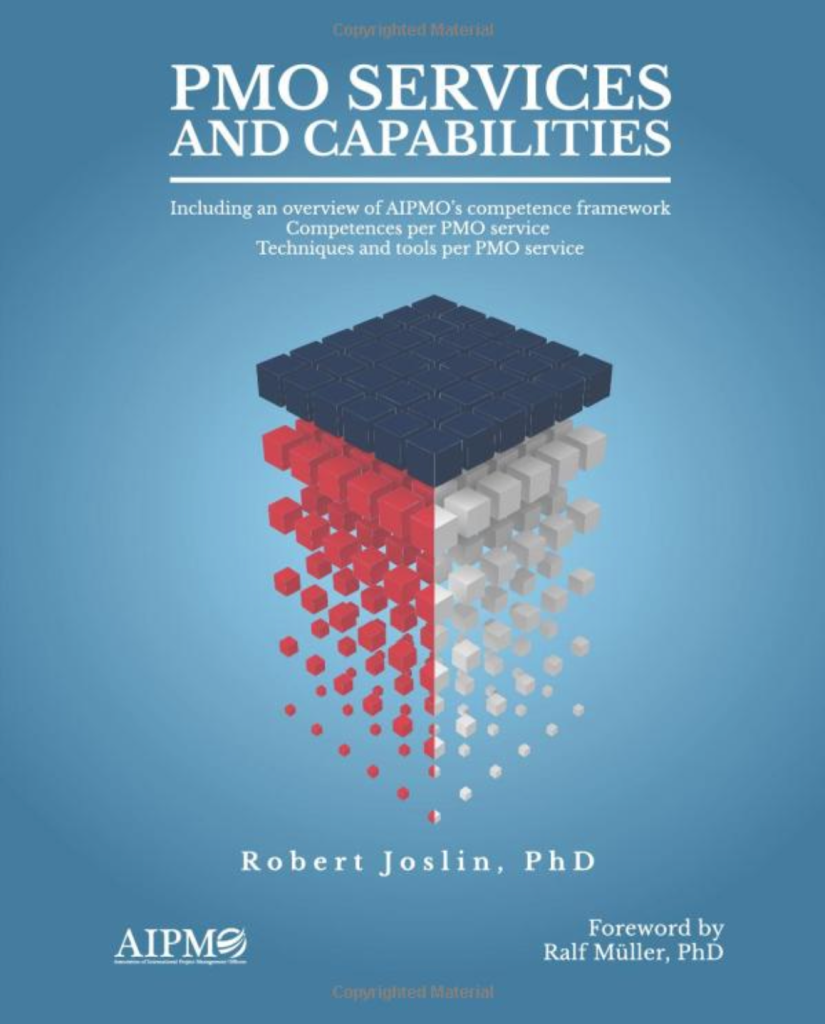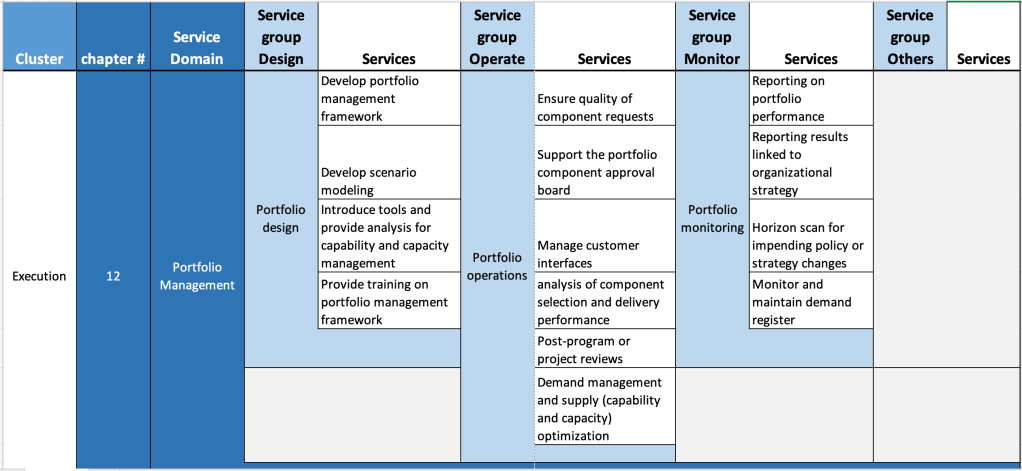
The book PMO Services and Capabilities – Including an overview of AIPMO’s competence framework – Competences per PMO service – Techniques and tools per PMO service is written by Robert Joslin. This book is unique as it addresses in a systematic and structured way for each PMO service including the associated attributes how to implement service to provide the right service to the right people at the right moment.
Each organizational unit is unique, each organizational unit needs its own set of PMO services.
The book is divided into two parts:
- The first small part contains a high level overview of AIPMO’s services lifecycle framework (service strategy, service design, service pilot and implementation, service operations, service transform or retire) as part of AIPMO’s methodology on how to build and implement a PMO services and capabilities catalog
- The second main part lists the PMO services that are in service groups and listed under the 22 service domains.
There are over 220 PMO services described in this book. The book is based on a three-level categorization system that allowed services to be grouped (service groups) with a service domain. A service domain is related to an area of experience. There are 22 service domains explained.
Each service domain is broken down into one to three service groups (in total approximately 60). A service group is related to one of the three main activity types that the PMO is expected to do:
- Design – a PMO can provide the standards, tools, templates, processes, procedures, help, guidance, framework that defines how work will operate within that particular service domain
- Operate – a PMO can operate (or perform) some of the work on behalf of other people within the project (program or portfolio) team. If the PMO does not perform this service then, if this is performed at all, then this will be done by another member of the project (program or portfolio) team
- Monitor – a PMO can review the work done by others and provide and independent quality assessment and check. They can provide reporting across the service domain and highlight items that require escalation.
Not all of the PMO activities fall neatly into the 3 groupings. For some of the services activities are categorized in a more relevant way. This has been done for ease of comprehension as it fits more naturally into how the service domain operates.
The 22 service domains explained in the book are: integration management, stakeholder management, communications management, governance, frameworks and methodologies management, PPM tools management, consultancy, portfolio management, benefits management, financial management, schedule management, risk management, quality management, supplier management, capability and capacity management, configuration management, change management, issue management, administrative management, innovation management, knowledge management and PMO self-development.
To give an example for the portfolio management service domain, its domain services and services.

Within each service group there are one or more services. A service is the lowest level of offering that a PMO can provide. The service domains are grouped into four clusters (conceptualization, planning, execution and safeguarding the future).
Each service has 2 audiences:
- The PMO How the service should be performed and some hints and tips that the PMO should consider when performing the service.
- The customer Why do you want to get this service, what would you expect to be delivered from this service, and why would you benefit.
For each service you get a description, what it provides for the customer, why is it being offered to the customer, SIPOC (Supplier, Input, Process, Output and Customer), demand triggers, measurement indicators, tips and tricks, needed capabilities (organizational enabler capabilities, personal capabilities, service domain capabilities, techniques, tools) and references to related services. Each service ends with suggestions for further reading.
Conclusion: I have never seen such a complete overview of PMO services for a single PMO. 1,7 kg heavy, 22 service domains with in total 60 service groups and more than 220 services. On the other hand, it isn’t complete. For sure there will be PMO’s offering services that are not explained in this book. New developments take place. E.g. the rise of Value Management Offices with their own specific services. But this is something the author mentions too and solutions to cover this will be offered in the near future. The book is structured as a reference work and will bring a lot of value for those involved in PMO’s. If you are involved in a PMO setting this is definitely a must have.
The only struggle I have is to find the place where a service is explained. Table 2.1 shows the service group mapping, but the services themselves aren’t mentioned. I would suggest replacing the domain number with the chapter number used in part 2 where all the services are explained. See also my example regarding portfolio management.
I am looking forward to some other titles AIPMO is preparing. E.g. Project, Program, Portfolio, and PMO Competences Frameworks: Designing for Successful Outcomes.
















Pingback: Overview of my year 2022 book reviews | Henny Portman's Blog
Pingback: Summary and review PMO Principles and PMO Services Principles Second Edition and Organizational, Portfolio, Program, and Project Principles | Henny Portman's Blog